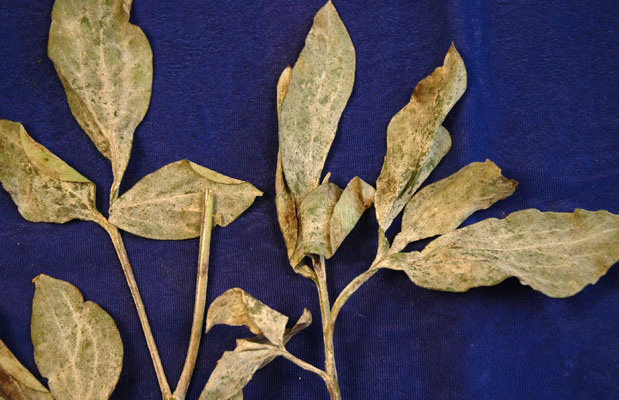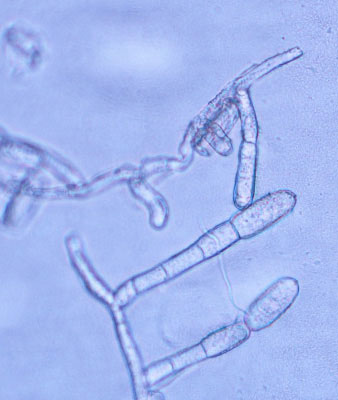Issue 12, July 16, 2010
Peony Powdery Mildew
I have grown peony plants in my gardens for nearly 20 years and have not seen powdery mildew as a problem on those plants. I have read about it from time to time but have not seen it on Plant Clinic samples. A recent peony sample at the University of Illinois Plant Clinic was covered with powdery mildew, as can be seen in the first image. The disease can be identified by its white, powdery growth covering the foliage. If you have access to a microscope you can see the Oidium spore stage like those in the second picture, courtesy of Horacio Lopez Nicora, one of the clinic diagnosticians. The spores are easily dislodged and moved from leaf to leaf by wind or water. Finding fruiting bodies of the overwintering stage of the fungus would clinch the species identification, but these had not yet formed on the sample. The fungus is Erysiphe polygoni.


According to the literature, this disease is becoming more common in landscapes. It is something to scout for on peonies. Preventive fungicides are available and usually recommended at the first sign of mildew. Registered fungicides include myclobutanil (Eagle, Myclobutanil, Spectracide Immunox Multipurpose Fungicide), propiconazole (Banner MAXX, ProPensity, Fertilome Systemic), thiophanate-methyl (Cleary 3336, SysTec, Fertilome Halt), potassium bicarbonate (Armicarb, Bonide Remedy), triadimefon (Bayleton, Bayer Advance Fungus Control), or sulfur. A note about sulfur: It may cause plant injury if applied in high heat (greater than 85 degrees F.).
A University of Illinois fact sheet on Powdery Mildews of Ornamentals is available on-line. Another reference on powdery mildews is one found on the Oregon State University web site. One author, Dr. Dean Glawe, is world renowned for his work with powdery mildews. He has many articles about powdery mildews in the scientific literature.--Nancy Pataky
Author:
Nancy Pataky